1~34 item / All 34 items
Displayed results
Filter by category
Added to bookmarks
Bookmarks listBookmark has been removed
Bookmarks listYou can't add any more bookmarks
By registering as a member, you can increase the number of bookmarks you can save and organize them with labels.
Free membership registration
Contact this company
Contact Us OnlineBefore making an inquiry
Download PDF1~34 item / All 34 items
Filter by category

We would like to introduce the "Strong Earthquake Observation Communication Program Modification." We have implemented a function to communicate with AccuSEIS Omni (manufactured by Katsushima Seisakusho) to download self-diagnosis and recorded waveforms. Our company is developing communication software. If you have any questions regarding the maintenance, data collection, or data analysis of strong motion seismometers, please feel free to contact us. 【Overview】 ■ Site Name: Earthquake Disaster Prevention Research ■ Client: National Institute for Land and Infrastructure Management, Ministry of Land, Infrastructure, Transport and Tourism *For more details, please download the PDF or feel free to contact us.
Added to bookmarks
Bookmarks listBookmark has been removed
Bookmarks listYou can't add any more bookmarks
By registering as a member, you can increase the number of bookmarks you can save and organize them with labels.
Free membership registration
At Technical Link Co., Ltd., we are developing a wire inspection robot for the underside of bridge deck slabs. Many of the road bridges currently in use in our country were constructed after the period of rapid economic growth. Therefore, it is clear that these road bridges will require large-scale repairs, reinforcements, or replacements in the future. In this situation, regular inspections of bridges play a very important role. This inspection wire robot (WRII type; WRII-NEXS ver1) is an improved version of the wire suspension type robot (WRI type), designed to obtain inspection image data on behalf of technicians in areas where visual inspection is not possible. [Features] ■ An inspection robot aimed at obtaining inspection image data in areas where visual inspection by technicians is not possible. *For more details, please download the PDF or feel free to contact us.
Added to bookmarks
Bookmarks listBookmark has been removed
Bookmarks listYou can't add any more bookmarks
By registering as a member, you can increase the number of bookmarks you can save and organize them with labels.
Free membership registration
The most important aspect of quality control during concrete placement is temperature management. After pouring concrete, special attention is required for low temperatures, dryness, and sudden temperature changes. Therefore, by using this technology to manage temperature, we can maintain quality. Since it is a system developed in-house, it has been customized according to site conditions. Our company has numerous achievements, particularly in bridge deck slabs. 【Features】 ■ In-house developed system ■ Numerous achievements, especially in bridge deck slabs *For more details, please download the PDF or feel free to contact us.
Added to bookmarks
Bookmarks listBookmark has been removed
Bookmarks listYou can't add any more bookmarks
By registering as a member, you can increase the number of bookmarks you can save and organize them with labels.
Free membership registration
The "Yureyure" that we handle is a proprietary system developed by our company, which has been engaged in continuous micro-motion observation, shaker experiments, the construction of various monitoring systems, and in-house software development. By analyzing the vibrations when a small shaker slightly vibrates a building, we evaluate its seismic performance. Currently, we are developing it with the goal of evaluating the seismic performance of general residential buildings. Please feel free to contact us if you have any inquiries. 【Features】 ■ Evaluates seismic performance by analyzing the vibrations when a small shaker slightly vibrates a building. ■ Currently developing with the goal of evaluating the seismic performance of general residential buildings. *For more details, please download the PDF or feel free to contact us.
Added to bookmarks
Bookmarks listBookmark has been removed
Bookmarks listYou can't add any more bookmarks
By registering as a member, you can increase the number of bookmarks you can save and organize them with labels.
Free membership registration
Introducing the motion capture software "TL-MotionCapture." It is possible to output the positions of markers as 2D coordinates from videos featuring objects with markers. Motion capture can be easily performed in a very inexpensive environment. 【Features】 ■ It is possible to output the positions of markers as 2D coordinates from videos featuring objects with markers. *For more details, please download the PDF or feel free to contact us.
Added to bookmarks
Bookmarks listBookmark has been removed
Bookmarks listYou can't add any more bookmarks
By registering as a member, you can increase the number of bookmarks you can save and organize them with labels.
Free membership registration
The purchase of measuring devices for fatigue testing machines is part of the business of building a system to automatically conduct fatigue tests. The main requirements include checking the status of the fatigue testing machine and monitoring the test specimens. Additionally, monitoring of load, number of repetitions, as well as measurement functions for strain, deflection, and temperature are also included in the requirements. 【Main Requirements】 ■ Status check of the fatigue testing machine ■ Monitoring of test specimens ■ Monitoring of load, number of repetitions, etc. ■ Measurement functions for strain, deflection, and temperature *For more details, please download the PDF or feel free to contact us.
Added to bookmarks
Bookmarks listBookmark has been removed
Bookmarks listYou can't add any more bookmarks
By registering as a member, you can increase the number of bookmarks you can save and organize them with labels.
Free membership registration
This is a system for monitoring the condition of buildings immediately after an earthquake, called "Displacement, Temperature, and Vibration Monitoring." When an earthquake is detected, it automatically measures the seismic waveform, temperature, and displacement, and the obtained data is transmitted to a server. The accumulated data can be checked from mobile devices. 【Features】 ■ A system for monitoring the condition of buildings immediately after an earthquake ■ Automatically measures seismic waveform, temperature, and displacement when an earthquake is detected, and transmits the obtained data to a server ■ Accumulated data can be checked from mobile devices *For more details, please download the PDF or feel free to contact us.
Added to bookmarks
Bookmarks listBookmark has been removed
Bookmarks listYou can't add any more bookmarks
By registering as a member, you can increase the number of bookmarks you can save and organize them with labels.
Free membership registration
We would like to introduce "vibration monitoring," which is used in construction at semiconductor factories and urban areas where efforts to reduce construction vibrations are required. The features of this system include the ability to light up a warning light when vibrations exceed the management threshold and to send email notifications to the administrator. Additionally, recorded data can be checked from mobile devices (iPhone, Android). 【Features】 ■ Warning light activates when vibrations exceed the management threshold ■ Email notifications can be sent to the administrator ■ Recorded data can be checked from mobile devices (iPhone, Android) *For more details, please download the PDF or feel free to contact us.
Added to bookmarks
Bookmarks listBookmark has been removed
Bookmarks listYou can't add any more bookmarks
By registering as a member, you can increase the number of bookmarks you can save and organize them with labels.
Free membership registration
We would like to introduce the "RC Slab Impact Vibration Test." This device is a specialized instrument developed in collaboration with the Tokyo Metropolitan Civil Engineering Technical Support and Human Resource Development Center to investigate the damage level of bridge RC slabs. This survey involves dropping a weight onto the center of the slab, and by measuring the free decay vibrations of the slab generated by the impact, it is possible to grasp the deflection, natural frequency, and damping constant. 【Features】 ■ Jointly developed with the Tokyo Metropolitan Civil Engineering Technical Support and Human Resource Development Center ■ Capable of measuring deflection, natural frequency, and damping constant *For more details, please download the PDF or feel free to contact us.
Added to bookmarks
Bookmarks listBookmark has been removed
Bookmarks listYou can't add any more bookmarks
By registering as a member, you can increase the number of bookmarks you can save and organize them with labels.
Free membership registration
We would like to introduce the "Basic Information Organization Work for Strong Earthquake Observation." For general strong earthquake observation stations and high-density strong earthquake observation stations (approximately 220 stations), we have organized the necessary information for management and compiled it into a database. Please feel free to contact us if you need our services. 【Business Overview】 ■ Site Name: Earthquake Disaster Prevention Research ■ Client: National Institute for Land and Infrastructure Management, Ministry of Land, Infrastructure, Transport and Tourism ■ Format: Regular Business *For more details, please download the PDF or feel free to contact us.
Added to bookmarks
Bookmarks listBookmark has been removed
Bookmarks listYou can't add any more bookmarks
By registering as a member, you can increase the number of bookmarks you can save and organize them with labels.
Free membership registration
We would like to introduce the "Strong Earthquake Observation Record Data Organization Service." We have organized the past strong earthquake observation record data stored on the server by the Earthquake Disaster Prevention Research Laboratory. The manufacturers of the strong earthquake observation equipment include Katsushima Manufacturing Co., Ltd., Mitutoyo Corporation, Rion Co., Ltd., Applied Seismology Co., Ltd., International Measurement Co., Ltd., and Tokyo Seismic Measurement Co., Ltd. Our company is capable of reading binary earthquake records from major seismometer manufacturers and performing analyses such as response spectra, Fourier spectra, and seismic motion indices. If you have any inquiries regarding the maintenance, data collection, or data analysis of strong seismometers, please feel free to contact us. 【Business Overview】 ■ Site Name: Earthquake Disaster Prevention Research Laboratory ■ Client: National Institute for Land and Infrastructure Management, Ministry of Land, Infrastructure, Transport and Tourism ■ Format: Regular Business *For more details, please download the PDF or feel free to contact us.
Added to bookmarks
Bookmarks listBookmark has been removed
Bookmarks listYou can't add any more bookmarks
By registering as a member, you can increase the number of bookmarks you can save and organize them with labels.
Free membership registration
I would like to introduce the "Commissioned Experiment on Wheel Load Running Fatigue of Steel Plate Bonded Reinforced Slabs." Due to wheel load running fatigue, delamination occurred in the steel plate bonded reinforced slabs. An experiment was conducted on test specimens that had been repaired by injecting adhesive into the delaminated areas, subjecting them to over 400,000 cycles of damage to confirm the effectiveness of the repair. 【Overview】 ■ Site Name: Tokyo Metropolitan Civil Engineering Technology Support and Human Resource Development Center, Toda Bridge Testing Ground ■ Client: Tokyo Metropolitan Government ■ Type: Regular Business *For more details, please download the PDF or feel free to contact us.
Added to bookmarks
Bookmarks listBookmark has been removed
Bookmarks listYou can't add any more bookmarks
By registering as a member, you can increase the number of bookmarks you can save and organize them with labels.
Free membership registration
We would like to introduce "Measurement of the Behavior of the Ultra Joint." To measure the three-axis (XYZ direction) displacement of the Ultra Joint, we have developed a three-axis displacement gauge. This three-axis displacement sensor is a combination of three Tokyo Sokki's displacement gauges (CE-10). The capacity is 10mm, and the resolution is 1/500mm. 【Overview】 ■ Developed a three-axis displacement gauge to measure the three-axis (XYZ direction) displacement of the Ultra Joint ■ The three-axis displacement sensor is a combination of three Tokyo Sokki's displacement gauges (CE-10) ■ Capacity is 10mm, resolution is 1/500mm *For more details, please download the PDF or feel free to contact us.
Added to bookmarks
Bookmarks listBookmark has been removed
Bookmarks listYou can't add any more bookmarks
By registering as a member, you can increase the number of bookmarks you can save and organize them with labels.
Free membership registration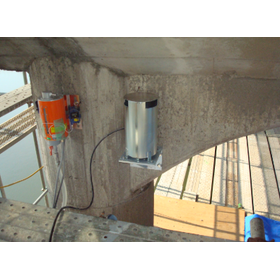
I would like to introduce the "Monitoring of the P3 Pier of the Fukurai Bridge." The Fukurai Bridge is a road bridge located in Fukuni Street, Joso City, Ibaraki Prefecture. Due to the Great East Japan Earthquake, the P3 pier has subsided, necessitating repair work. To understand whether the subsidence of this pier is ongoing and to assess its load-bearing capacity, we conducted monitoring of the displacement and tilt of this pier. 【Measurement Items】 ■ Vertical displacement of the P3 pier ■ Tilt of the P3 pier in two axes (X, Y) *For more details, please download the PDF or feel free to contact us.
Added to bookmarks
Bookmarks listBookmark has been removed
Bookmarks listYou can't add any more bookmarks
By registering as a member, you can increase the number of bookmarks you can save and organize them with labels.
Free membership registration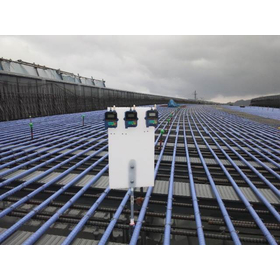
We would like to introduce "Temperature Management during the Concrete Curing Period." An important aspect of quality control during concrete placement is temperature management. After the concrete is poured, special attention is needed for low temperatures, dryness, and sudden temperature changes. By managing the temperature using our technology, we can maintain quality. Since it is a system developed in-house, it has been customized according to site conditions. We have numerous achievements, particularly with bridge deck slabs. [Overview] ■ Quality can be maintained by managing temperature ■ Customized according to site conditions due to in-house developed system ■ Numerous achievements, especially with bridge deck slabs *For more details, please download the PDF or feel free to contact us.
Added to bookmarks
Bookmarks listBookmark has been removed
Bookmarks listYou can't add any more bookmarks
By registering as a member, you can increase the number of bookmarks you can save and organize them with labels.
Free membership registration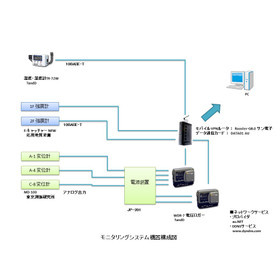
The "Displacement, Temperature, and Vibration Monitoring System" is a system that monitors the condition of buildings immediately after an earthquake. When an earthquake is detected, it automatically measures seismic waveforms, temperature, and displacement, and the obtained data is transmitted to a server. The accumulated data can be checked from mobile devices. 【Features】 ■ A system that monitors the condition of buildings immediately after an earthquake ■ Automatically measures seismic waveforms, temperature, and displacement when an earthquake is detected, and transmits the obtained data to a server ■ Accumulated data can be checked from mobile devices *For more details, please download the PDF or feel free to contact us.
Added to bookmarks
Bookmarks listBookmark has been removed
Bookmarks listYou can't add any more bookmarks
By registering as a member, you can increase the number of bookmarks you can save and organize them with labels.
Free membership registration
The "Vibration Monitoring System" is used in construction projects where efforts to reduce construction vibrations are required, such as in semiconductor factories and urban areas. The feature of this system is that it can light up a warning light when vibrations exceed the vibration management threshold and send email notifications to the administrator. Additionally, recorded data can be checked from mobile devices (iPhone, Android). 【Features】 ■ It can light up a warning light when vibrations exceed the vibration management threshold and send email notifications to the administrator. ■ Recorded data can be checked from mobile devices. *For more details, please download the PDF or feel free to contact us.
Added to bookmarks
Bookmarks listBookmark has been removed
Bookmarks listYou can't add any more bookmarks
By registering as a member, you can increase the number of bookmarks you can save and organize them with labels.
Free membership registration
I would like to introduce the "Verification of Strong Earthquake Observation Facility Recording Function for 2015." We inspected the strong earthquake observation facility (AccuSEIS Omni, Katsushima Manufacturing). If you have any questions regarding the maintenance, data collection, or data analysis of the strong motion seismometers, please feel free to contact us. 【Business Content】 ■ Inspection of the strong earthquake observation facility (AccuSEIS Omni, Katsushima Manufacturing) *For more details, please download the PDF or feel free to contact us.
Added to bookmarks
Bookmarks listBookmark has been removed
Bookmarks listYou can't add any more bookmarks
By registering as a member, you can increase the number of bookmarks you can save and organize them with labels.
Free membership registration
I would like to introduce the "Operation Confirmation Work for Strong Motion Observation Equipment for Fiscal Year 2015." We conducted inspections of the strong motion observation equipment (manufactured by SAMTAC Co., Ltd., Tokyo). If you have any questions regarding the maintenance, data collection, or data analysis of the strong motion meters, please feel free to contact us. 【Business Overview】 ■ Inspections of strong motion observation equipment (manufactured by SAMTAC Co., Ltd., Tokyo) were conducted. * For more details, please download the PDF or feel free to contact us.
Added to bookmarks
Bookmarks listBookmark has been removed
Bookmarks listYou can't add any more bookmarks
By registering as a member, you can increase the number of bookmarks you can save and organize them with labels.
Free membership registration
We would like to introduce the "Stress Investigation of G Bridge." To create foundational data for maintenance management, we conducted a traffic condition survey and stress frequency measurement (using the rain flow method and peak valley method) using the BWIM system. Additionally, we also calculated the estimated remaining lifespan based on these results. 【Business Overview】 ■ Conducted a traffic condition survey and stress frequency measurement (using the rain flow method and peak valley method) using the BWIM system to create foundational data for maintenance management. ■ Calculated the estimated remaining lifespan based on these results. *For more details, please download the PDF or feel free to contact us.
Added to bookmarks
Bookmarks listBookmark has been removed
Bookmarks listYou can't add any more bookmarks
By registering as a member, you can increase the number of bookmarks you can save and organize them with labels.
Free membership registration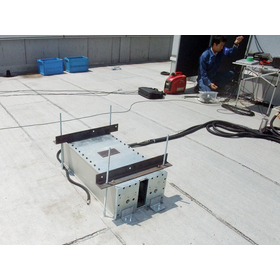
I would like to introduce the "Shaking Table Experiment of Building 3 at Kanagawa University Yokohama Campus." Building 3 of the campus, completed in March 2014, is a steel structure with 2 basement levels (reinforced concrete) and 4 above-ground levels (steel), featuring a damage control structure using buckling-restrained braces. Our company assisted with the shaking table experiment for this building. [Overview] - Building 3 of the campus is a steel structure with 2 basement levels (reinforced concrete) and 4 above-ground levels (steel), utilizing a damage control structure with buckling-restrained braces. - We assisted with the shaking table experiment for this building. *For more details, please download the PDF or feel free to contact us.
Added to bookmarks
Bookmarks listBookmark has been removed
Bookmarks listYou can't add any more bookmarks
By registering as a member, you can increase the number of bookmarks you can save and organize them with labels.
Free membership registration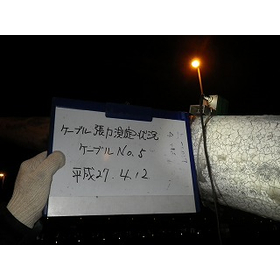
We would like to introduce the "Maintenance and Management of Cable-Stayed Bridges." A cable-stayed bridge is a type of bridge that supports the main girder with cables that are diagonally stretched from a main tower built on piers. Due to this structure, the cable components are crucial elements that determine the shape of the bridge, and any change in the tension balance of the cables increases the stress on the girder, tower, and bearings, leading to strain in each component. Therefore, for important cable-stayed bridges, we regularly inspect the cable tension and the shape of the bridge (longitudinal profile). [Overview of Services] - A cable-stayed bridge is a structure that supports the main girder with cables that are diagonally stretched from a main tower built on piers. - The cable components are crucial elements that determine the shape of the bridge, and any change in the tension balance of the cables increases the stress on the girder, tower, and bearings, leading to strain in each component. - Important cable-stayed bridges are regularly inspected for cable tension and bridge shape (longitudinal profile). *For more details, please download the PDF or feel free to contact us.
Added to bookmarks
Bookmarks listBookmark has been removed
Bookmarks listYou can't add any more bookmarks
By registering as a member, you can increase the number of bookmarks you can save and organize them with labels.
Free membership registration
We will introduce the "Inspection and Investigation of Vibration Control Devices." To evaluate the performance of the vibration control devices installed on the cables of the cable-stayed bridge, a shaker test was conducted. The test involved exciting the cables with the shaker set to the first to fifth natural frequencies, stopping the excitation when the vibrations increased, and recording the subsequent free decay vibration waveforms. 【Business Overview】 ■ Conducted shaker tests to evaluate the performance of the vibration control devices installed on the cables of the cable-stayed bridge. ■ Stopped the excitation when the vibrations increased and recorded the subsequent free decay vibration waveforms. ■ The shaker tests were conducted in two cases: with and without the vibration control device, and the damping performance of the device was evaluated by comparing the logarithmic decay rates of these cases. *For more details, please download the PDF or feel free to contact us.
Added to bookmarks
Bookmarks listBookmark has been removed
Bookmarks listYou can't add any more bookmarks
By registering as a member, you can increase the number of bookmarks you can save and organize them with labels.
Free membership registration
We would like to introduce the "Vibration Characteristics Survey for the National Treasure Bronze Amida Nyorai Sitting Statue." We conducted continuous micro-vibration measurements of the statue and assisted the Tokyo National Research Institute for Cultural Properties in their investigation. This time, we aimed to understand the natural period and vibration characteristics of the statue, which is equipped with a sliding seismic isolation device made of stainless steel, and we conducted this survey simultaneously. 【Survey Overview】 - Continuous micro-vibration measurements were conducted using a highly sensitive servo-type velocimeter (Tokyo Sokushin), measuring 24 components simultaneously at 8 locations with 3 components each. - We analyzed these velocity waveforms (transfer functions and Fourier spectra) to grasp the natural frequencies and dynamic characteristics. - By using 24 highly sensitive servo-type velocimeters (Tokyo Sokushin) for simultaneous measurements, we were able to obtain highly accurate and reliable valuable data. *For more details, please download the PDF or feel free to contact us.
Added to bookmarks
Bookmarks listBookmark has been removed
Bookmarks listYou can't add any more bookmarks
By registering as a member, you can increase the number of bookmarks you can save and organize them with labels.
Free membership registration
We would like to introduce the "Shear Wave Velocity Measurement Work for Gravity Dams." The purpose is to estimate the strength of concrete by calculating the elastic modulus from the shear wave velocity. Accelerometers were placed in the inspection gallery of the gravity concrete dam, and vibrations were applied using a hammer near the reference point, measuring the acceleration during this process. The impact vibrations were separated into cases for P-wave velocity and S-wave velocity, with more than five vibrations conducted for each case. The sampling frequency of the recording device was set to over 10 kHz, and the time history waveforms of the accelerometers were recorded. 【Measurement Overview】 - Accelerometers were placed in the inspection gallery of the gravity concrete dam, and vibrations were applied using a hammer near the reference point, measuring the acceleration during this process. - Impact vibrations were separated into cases for P-wave velocity and S-wave velocity, with more than five vibrations conducted for each case. - The sampling frequency of the recording device was set to over 10 kHz, and the time history waveforms of the accelerometers were recorded. *For more details, please download the PDF or feel free to contact us.*
Added to bookmarks
Bookmarks listBookmark has been removed
Bookmarks listYou can't add any more bookmarks
By registering as a member, you can increase the number of bookmarks you can save and organize them with labels.
Free membership registration
We would like to introduce the traffic condition survey "BWIM." Using a system developed by the National Institute for Land and Infrastructure Management's Bridge Research Laboratory, which allows for the simple measurement of vehicle weights and other parameters (Bridge Weigh-in-Motion), we carry out bridge maintenance and management operations. Our company conducts traffic condition surveys and stress frequency measurements using this system, as well as remaining lifespan prediction analysis. [Overview] ■ We implement bridge maintenance and management operations using a system (Bridge Weigh-in-Motion) that allows for the simple measurement of vehicle weights and other parameters. ■ We conduct traffic condition surveys and stress frequency measurements, as well as remaining lifespan prediction analysis using the "BWIM system." *For more details, please download the PDF or feel free to contact us.
Added to bookmarks
Bookmarks listBookmark has been removed
Bookmarks listYou can't add any more bookmarks
By registering as a member, you can increase the number of bookmarks you can save and organize them with labels.
Free membership registration
To evaluate the performance of the horizontal vibration device "M009" using a linear motor, we conducted an "excitation machine experiment on a three-story building." We carried out practical vibration experiments such as sweep vibration tests and steady-state vibration tests (2.5Hz to 7.5Hz) to confirm the operating conditions and usability. [Summary] ■ Conducted an excitation machine experiment on a three-story building to evaluate the performance of the horizontal vibration device using a linear motor. ■ Carried out practical vibration experiments such as sweep vibration tests and steady-state vibration tests to confirm the operating conditions and usability. *For more details, please download the PDF or feel free to contact us.
Added to bookmarks
Bookmarks listBookmark has been removed
Bookmarks listYou can't add any more bookmarks
By registering as a member, you can increase the number of bookmarks you can save and organize them with labels.
Free membership registration
A "static load test" was conducted to understand the bearing capacity of the P3 pier. The Fukurai Bridge is a road bridge spanning Fukuni Street in Joso City, Ibaraki Prefecture, and repair work is planned due to the settlement of the P3 pier caused by the Great East Japan Earthquake. The measurement of the pier's settlement was carried out using a communicating pipe type displacement gauge, and the tilt angle was measured with a stationary two-axis inclinometer. The load was applied by placing a plastic tank on the P3 pier and pumping water from the river to reach up to 60 kN in increments of 10 kN. 【Test Overview】 ■ The measurement of the pier's settlement was conducted using a communicating pipe type displacement gauge, and the tilt angle was measured with a stationary two-axis inclinometer. ■ The load was applied by placing a plastic tank on the P3 pier and pumping water from the river to reach up to 60 kN in increments of 10 kN. ■ The vertical displacement of the P3 pier and the two-axis (X, Y) tilt were measured at this time. ■ To confirm daily fluctuations, automatic measurements were conducted for about one week before and one week after the static load test. *For more details, please download the PDF or feel free to contact us.
Added to bookmarks
Bookmarks listBookmark has been removed
Bookmarks listYou can't add any more bookmarks
By registering as a member, you can increase the number of bookmarks you can save and organize them with labels.
Free membership registration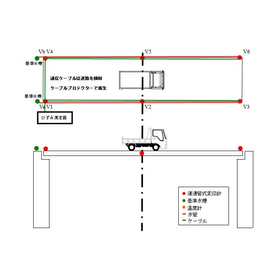
The "static load test of bridges" is conducted to evaluate the integrity of the girder. The testing method involves placing a known test vehicle at the center of the span and measuring the deflection of the girder at that time. From the relationship between the obtained load and deflection, the integrity of the girder can be assessed. Here, we introduce a method using a communicating tube type displacement gauge for measuring the deflection of the girder. 【Features】 ■ The deflection of the girder can be measured with a resolution of 1/20 mm. ■ The communicating tube type displacement gauge can be installed on top of the girder, making it easy to work with. *For more details, please download the PDF or feel free to contact us.
Added to bookmarks
Bookmarks listBookmark has been removed
Bookmarks listYou can't add any more bookmarks
By registering as a member, you can increase the number of bookmarks you can save and organize them with labels.
Free membership registration
We would like to introduce the "E-0.5KN Vibration Generator" that we handle. It uses a method where the weight is moved by the rotation of a pole screw, and since the weight is directly connected to the motor, no noise is generated. Additionally, because it is a method of attaching weights, the main unit is lightweight (33kg), and it features a simple mechanism with fewer breakdowns. 【Features】 ■ Method of moving the weight by the rotation of the pole screw ■ No noise generated as the weight is directly connected to the motor ■ Lightweight main unit (33kg) due to the weight attachment method ■ Simple mechanism with fewer breakdowns ■ Can use AC100V power supply *For more details, please download the PDF or feel free to contact us.
Added to bookmarks
Bookmarks listBookmark has been removed
Bookmarks listYou can't add any more bookmarks
By registering as a member, you can increase the number of bookmarks you can save and organize them with labels.
Free membership registration
This technical document introduces the "Vibration Exciter" handled by Technical Link Co., Ltd. It provides detailed information using diagrams and tables on the purpose of vibration experiments, the principles of the exciter, experimental methods and results, and an overview of each exciter. Please make use of this information for product handling. [Contents (partial)] ■1. Purpose of Vibration Experiments ■2. Principles of the Exciter ■3. Overview of the M-9KN Exciter ■4. Experimental Methods and Results (when applied to buildings) ■5. Overview of the M-3KN Exciter, etc. *For more details, please refer to the PDF document or feel free to contact us.
Added to bookmarks
Bookmarks listBookmark has been removed
Bookmarks listYou can't add any more bookmarks
By registering as a member, you can increase the number of bookmarks you can save and organize them with labels.
Free membership registration
The "IIS-T2000" is a specialized device developed in collaboration with the Tokyo Metropolitan Civil Engineering Technical Support and Human Resource Development Center for investigating the damage level of bridge RC slabs. This survey involves dropping a weight onto the center of the slab and measuring the free decay vibrations of the slab generated by the impact excitation, allowing us to understand the deflection, natural frequency, and damping constant. 【Features】 ■ Investigates the damage level of bridge RC slabs ■ Capable of removing the vibration components of the girder ■ Patent No. 2938810 Method for measuring deflection of slabs *For more details, please refer to the PDF document or feel free to contact us.
Added to bookmarks
Bookmarks listBookmark has been removed
Bookmarks listYou can't add any more bookmarks
By registering as a member, you can increase the number of bookmarks you can save and organize them with labels.
Free membership registration
"Spider Eye" is a new inspection method for areas where bridge inspections are difficult. As one of the close visual inspection methods, it enables the assessment of damage conditions using a high-performance camera. We offer a "Standard Type" that excels in detecting cracks on the underside of the deck and a "Lifting Type" that is effective for assessing conditions in corner areas. It can be used in locations such as between main girders and cantilever sections where inspection paths are not installed. 【Features】 <Standard Type> ■ Assesses deformation conditions equivalent to the naked eye ■ Can distinguish damage and cracks wider than 0.2mm from captured images ■ Lateral removal through image synthesis is possible ■ The system is simple as the movement of the equipment is done manually *For more details, please refer to the PDF document or feel free to contact us.
Added to bookmarks
Bookmarks listBookmark has been removed
Bookmarks listYou can't add any more bookmarks
By registering as a member, you can increase the number of bookmarks you can save and organize them with labels.
Free membership registration
In the "Ground Investigation Service," we can understand the vibration characteristics and health of the subject of investigation without damaging the measurement target. Our company not only handles measurement tasks but also provides comprehensive support in the field of ground and structure investigation, from formulating overall plans on what and how to measure to proposing data analysis. 【Investigation Achievements】 ■ Static load testing of bridges ■ Static load testing of Fukurai Bridge ■ Shaking table experiments for a three-story building ■ Traffic condition surveys (BWIM) ■ Shear wave velocity measurement for gravity dams, etc. *For more details, please feel free to contact us.
Added to bookmarks
Bookmarks listBookmark has been removed
Bookmarks listYou can't add any more bookmarks
By registering as a member, you can increase the number of bookmarks you can save and organize them with labels.
Free membership registration